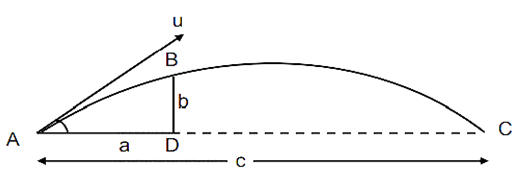Equation Of Path Of A Projectile
The equation of the path of a projectile describes the curved trajectory followed by an object that is launched into the air under the influence of gravity, assuming negligible air resistance. This concept is not just confined to textbooks but is widely observable in real life. Whether it's the arc of a basketball thrown towards a hoop, the flight of a soccer ball after being kicked, or even the water flowing out of a fountain, all these motions can be modelled using the projectile motion equation. Understanding this equation allows us to predict the path of any object thrown or projected, which is essential in fields like sports, engineering, and even space exploration. It helps in optimizing the angle and speed of launch to achieve the desired target, showcasing the relevance of this mathematical principle in everyday activities and professional practices.
JEE Main/NEET 2027: Physics Important Formulas for Class 10
NEET 2025: Mock Test Series | Syllabus | High Scoring Topics | PYQs
JEE Main: Study Materials | High Scoring Topics | Preparation Guide
JEE Main: Syllabus | Sample Papers | Mock Tests | PYQs
- Projectile Motion
- Equation of Path of a Projectile
- Solved Question Besed On Equation Of Path Of A Projectile
- Summary

Projectile Motion
Two-dimensional motions under the action of the uniform force are called projectile motion.
E.g- A javelin thrown by an athlete

Projectile Projected at an angle
Initial Velocity- u
Horizontal component
Vertical component
Final velocity
Horizontal component
Vertical component
So,
Displacement = S
Horizontal component
Vertical component
and,
Acceleration
Horizontal component
Vertical component
So,
Parameters In Projectile Motion
1) Maximum Height -
Maximum vertical distance attained by a projectile during its journey.
Formula,
When the velocity of the projectile increases n time then the Maximum height is increased by a factor of
Special Case: If U is doubled, H becomes four times provided
2) Time of Flight -
Time for which projectile remains in the air above the horizontal plane.
Formula,
Time of ascent
Time of descent
Notes:
- When the velocity of the projectile increases n time then the Time of ascent becomes n times.
- When the velocity of the projectile increases n time then the Time of descent becomes n times.
- When the velocity of the projectile increases n time then the time of flight becomes n times.
3) Horizontal Range
Horizontal distance travelled by a projectile from the point of the projectile to the point on the ground where it hits.
Formula,
The special case of horizontal range:
- For max horizontal range.
- Range remains the same whether the projectile is thrown at an
- When the velocity of the projectile increases n time then the horizontal range is increased by a factor of
- When the horizontal range is n times the maximum height then,
Equation of Path of a Projectile

or-
Where R is the horizontal range of the projectile.
It is the equation of the parabola, So the trajectory/path of the projectile is
parabolic in nature
Recommended Topic Video
Solved Question Besed On Equation Of Path Of A Projectile
Example 1: The trajectory of a projectile near the surface of the earth is given as
1)
2)
3)
4)
Solution:
Given :
The standard equation of trajectory for a projectile
On comparing Eq. (1) and (2)
Hence, the answer is the Option (3).
Example 2: A particle just clears a wall of height b at a distance a and strikes the ground at a distance c from the point of projection. The angle of projection is:
1)
2)
3)
4)
Solution:

Hence, the answer is option (1).
Example 3:
1)
2)
3)
4)
Solution:
Hence, the answer is the option (1).
Example 4: A projectile is given an initial velocity of
1)
2)
3)
4)
Solution:
Given :
From the equation of motion,
After comparing both sides, we get,
Now, put the value of
Hence, the answer is the option (3).
Example 5: A body of mass
1)
2)
3)
4)
Solution:

We know that the equation of trajectory is
Also, we know that,
Hence, the answer is option (1).
Summary
In summary, the equation of the path of a projectile is one of the cornerstone equations of physics, permitting great precision in the prediction and, hence, analysis of such described trajectories of the objects thrown into the atmosphere. This general movement, forming a parabola, due to the known movements under the law of the earth's gravity force in action, is core to understanding and optimizing the trajectory of the moving projectiles in different real-life scenarios.
Also Read
25 Sep'24 12:54 PM
24 Sep'24 10:57 PM
24 Sep'24 10:37 PM
18 Sep'24 04:22 PM
05 Sep'24 04:33 PM

